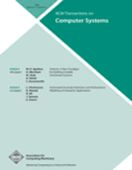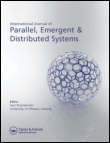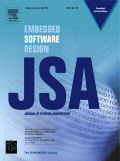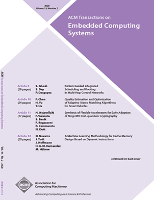
ACM TRANSACTIONS ON COMPUTER SYSTEMS
Scope & Guideline
Elevating Knowledge in the Evolving Landscape of Computer Systems
Introduction
Aims and Scopes
- Resource Management and Optimization:
Research in this area focuses on efficient resource allocation and management strategies within computer systems. This includes optimizing performance for shared resources in microservices, memory management frameworks, and systems for heterogeneous computing environments. - Virtualization and Containerization:
The journal emphasizes advancements in virtualization technologies, including frameworks for managing tiered memory and container migration. Papers often explore the interplay between hardware and software in virtualized environments, enhancing efficiency and scalability. - Networking and Communication Protocols:
Publications include studies on network architecture, inter-process communication, and network-on-chip designs. This area addresses challenges in data transmission, security, and performance optimization in distributed systems. - High-Performance Computing and Architectures:
Research contributions often revolve around enhancing computational efficiency through innovative architectures, such as those for GPUs and multi-core systems, as well as optimizing algorithms for high-throughput computing. - Data Processing Frameworks and Big Data:
The journal covers advancements in frameworks for big data processing, emphasizing the need for unified memory management and efficient data handling strategies across diverse computing environments.
Trending and Emerging
- Heterogeneous Computing and Memory Management:
Research focusing on heterogeneous architectures and memory management frameworks is on the rise. This includes studies on tiered memory systems and heterogeneous-ISA container migration, reflecting the growing importance of optimizing resources in diverse computing environments. - Microservices and Cloud Computing Optimization:
The trend towards microservices architecture is evident, with increasing research on resource management and scalability in cloud environments. This reflects a broader industry shift towards modular, efficient service-oriented architectures. - Blockchain and Data Provenance:
Emerging interest in blockchain technologies and their applications in data management and security is notable. The reformulation of blockchain into composable structures for cross-domain applications signifies a growing interdisciplinary focus. - AI and Machine Learning Integration in Systems Design:
There is a rising trend in integrating AI and machine learning techniques into system design, particularly in optimizing performance and resource utilization for data center applications, indicating a pivotal shift towards intelligent systems. - Real-time and Adaptive Systems:
Research on real-time systems and adaptive computing solutions is gaining traction, emphasizing the need for systems that can adjust dynamically to varying workloads and environments.
Declining or Waning
- Traditional Operating System Mechanisms:
While foundational operating systems concepts remain important, there seems to be a shift away from traditional operating system topics in favor of more dynamic and scalable solutions such as microservices and containerization. - Static Analysis Techniques:
Research on static analysis methods is appearing less frequently, possibly indicating a shift towards more dynamic and real-time analysis techniques that can better accommodate modern system complexities. - Legacy Hardware Integration:
There is a noticeable reduction in studies focusing on integrating legacy hardware systems, as the community increasingly prioritizes novel architectures and heterogeneous systems that can better meet current computational demands.
Similar Journals

Journal of Grid Computing
Illuminating Trends in Computer Networks and ArchitectureThe Journal of Grid Computing, published by Springer, stands as a pivotal resource in the dynamic field of computer science, particularly within the realms of Computer Networks and Communications, Hardware and Architecture, Information Systems, and Software. With an impressive Q1 ranking across these categories in 2023, the journal exemplifies excellence and rigor, catering to a diverse readership from researchers to industry professionals. Established in 2003, this esteemed journal is anchored in the Netherlands and releases cutting-edge research that reflects trends and advancements in grid computing technologies. Researchers can gain insights through its vast contributions, while institutions benefit from its prestigious standing within the SCOPUS framework, boasting high percentile ranks in multiple computer science categories. Though not open access, the journal provides unparalleled access options for institutional subscribers, solidifying its importance as a gateway to innovative discoveries in high-performance distributed computing.

International Journal of Electronics and Telecommunications
Empowering Innovation in Communication TechnologiesWelcome to the International Journal of Electronics and Telecommunications, a prominent publication dedicated to the evolving fields of electronics, telecommunications, and computer networks. Established by the Polska Akademia Nauk (Polish Academy of Sciences), this journal is committed to fostering academic research and technological advancements within these crucial domains. As of 2023, it holds a Q4 ranking in both Computer Networks and Communications and Electrical and Electronic Engineering, showcasing its role as a platform for emerging ideas and groundbreaking studies. With an Open Access model implemented since 2013, it enhances the visibility and accessibility of its articles, encouraging a broader impact and collaboration among researchers, professionals, and students alike. The journal serves as an important resource for those interested in the intersection of technology and communications, and it continues to contribute to the academic dialogue surrounding these vital sectors.

International Journal of Parallel Emergent and Distributed Systems
Connecting Scholars and Practitioners in Cutting-edge ComputingInternational Journal of Parallel Emergent and Distributed Systems, published by Taylor & Francis Ltd, is a prestigious academic journal aimed at advancing the fields of parallel computing, distributed systems, and emergent technologies. With an ISSN of 1744-5760 and E-ISSN 1744-5779, this journal has been a vital resource for researchers and professionals since its inception in 2005. As a part of the Q3 category in Computer Networks and Communications and Q4 in Software, it reflects a growing interest and engagement in these critical areas of study, with Scopus rankings highlighting its significance in computer science. Although currently not an open-access journal, its comprehensive exploration of innovative methodologies, systems design, and distributed computing paradigms makes it essential reading for anyone involved in cutting-edge research and application development. The journal not only aims to disseminate novel insights but also serves as a platform to foster dialogue among practitioners and scholars alike, making it a cornerstone in the academic landscape of emergent technologies.

International Journal of Business Data Communications and Networking
Connecting Ideas, Empowering Innovations.The International Journal of Business Data Communications and Networking, published by IGI Global, stands as a pivotal resource in the fields of business and technology, particularly focusing on the interplay between data communications and network systems. With an established presence since 2005, this journal has been instrumental in disseminating research that bridges the gaps between computer networks, management information systems, and business practices. It holds a commendable position in the academic community, reflected in its Q3 rankings in both Computer Networks and Communications and Management Information Systems categories for 2023, alongside respectable Scopus rankings that underline its relevance and contribution to the field. While it operates on a subscription basis, the journal's commitment to quality research makes it an essential read for researchers, practitioners, and students eager to stay abreast of the latest developments and innovations. The journal aims to foster a deeper understanding of the complexities surrounding business communications and data networking, encouraging the advancement of knowledge and practical application in these ever-evolving domains.

INTERNATIONAL JOURNAL OF PARALLEL PROGRAMMING
Elevating Knowledge in Theoretical Computer ScienceInternational Journal of Parallel Programming, published by Springer/Plenum Publishers, is a prestigious peer-reviewed journal that has been at the forefront of research in parallel programming since its inception. With a commitment to advancing methodologies and applications in parallel processing, this journal serves a diverse audience of researchers, professionals, and students in the fields of Information Systems, Software, and Theoretical Computer Science. The journal's impact is evident in its respectable 2023 Scopus rankings, where it holds a position in the 68th percentile for Theoretical Computer Science and a solid standing in related categories. Its publication years span crucial developments in computing, making it an essential resource for anyone interested in parallel programming advancements. Although currently not offering open access, the journal ensures high-quality dissemination of knowledge and innovative research findings through its rigorous editorial standards. International Journal of Parallel Programming continues to be integral for those wishing to explore critical research and developments that influence the dynamic landscape of parallel computing.

IEEE NETWORK
Advancing the Future of Networking TechnologiesIEEE NETWORK is a premier journal published by the IEEE-INST ELECTRICAL ELECTRONICS ENGINEERS INC, dedicated to advancing the field of computer networks and communication systems. Recognized for its rigorous peer-review process, this journal holds a prestigious Q1 ranking in multiple categories including Computer Networks and Communications, Hardware and Architecture, Information Systems, and Software according to the 2023 metrics. With a focus on delivering cutting-edge research findings and innovative technologies, IEEE NETWORK aims to bridge academia and industry, providing a vital platform for the dissemination of knowledge among researchers, professionals, and students. While it operates under a subscription-based model, the journal remains a key resource for those seeking to stay informed on the latest trends and developments in the networking domain. Established in 1986 and continuing its publication through 2024, it serves as a critical reference for impactful research that shapes the future of networking technologies.

Frontiers in Communications and Networks
Exploring the Nexus of Networks and Signal ProcessingFrontiers in Communications and Networks is a prominent open-access journal published by FRONTIERS MEDIA SA, established in 2020 and positioned in the heart of Switzerland. As an interdisciplinary platform, it focuses on advancing research related to computer networks, communications, and signal processing, providing a critical forum for innovative findings and developments in these rapidly evolving fields. With an impressive Q1 ranking in Computer Networks and Communications and a Q2 ranking in Signal Processing as of 2023, this journal is highly regarded among scholars and practitioners seeking to disseminate their work to a broad audience. By offering open-access options, it ensures that the research is widely available, fostering collaboration and knowledge sharing across the globe. Researchers, professionals, and students are encouraged to engage with the journal as it aims to encapsulate the burgeoning advancements shaping our digital communication landscape.

JOURNAL OF SYSTEMS ARCHITECTURE
Elevating Standards in Systems Architecture ResearchJOURNAL OF SYSTEMS ARCHITECTURE is a prestigious academic journal published by ELSEVIER, based in the Netherlands, that has established itself as a leading platform for research in the fields of Hardware and Architecture and Software. With an impressive impact factor and ranked in the Q1 category for both computer science sectors, this journal is recognized for its high-quality contributions, evidenced by its Scopus ranking of #32 in Hardware and Architecture and #74 in Software, placing it in the top percentiles of its field. The journal spans a wide range of topics central to systems architecture, focusing on innovative research that advances the understanding of computer systems and promotes future developments. Researchers, professionals, and students alike will find invaluable insights and emerging trends that address the challenges and opportunities within the rapidly evolving field of systems design and architecture. Spanning from 1996 to 2024, the JOURNAL OF SYSTEMS ARCHITECTURE continues to be a vital resource for those seeking to stay at the forefront of technology and research.

DISTRIBUTED COMPUTING
Elevating Knowledge in Computational ExcellenceDISTRIBUTED COMPUTING is a prestigious journal published by SPRINGER that has been a significant contributor to the fields of computational theory, computer networks, and hardware architecture since its inception in 1986. With its ISSN 0178-2770 and E-ISSN 1432-0452, this scholarly publication stands out for its rigorous peer-review process and its commitment to advancing knowledge in distributed systems. The journal has consistently ranked in the Q1 category for multiple relevant domains, reflecting its high impact within the academic community. Although not an open-access journal, DISTRIBUTED COMPUTING offers essential insights and research contributions that are invaluable to researchers, professionals, and students alike. Its scope encompasses various aspects of computational theory and mathematics, ensuring a comprehensive approach to the complexities of distributed systems. With an address in New York, USA, and a delivery timeline extending to 2024, this journal is poised to continue influencing the landscape of computer science and beyond.

ACM Transactions on Embedded Computing Systems
Pioneering research that shapes the landscape of embedded systems.ACM Transactions on Embedded Computing Systems (ISSN: 1539-9087, E-ISSN: 1558-3465), published by the Association for Computing Machinery, is a premier academic journal dedicated to advancing the study and application of embedded computing systems. With a focus on both hardware and software aspects, this journal holds a distinguished Q2 ranking in its field (2023) and has achieved notable recognition within Scopus rankings, particularly in Hardware and Architecture (Rank #97/177) and Software (Rank #231/407). Encompassing research from 2002 to 2024, it serves as a crucial platform for disseminating cutting-edge findings that drive innovation and foster scholarly dialogue among researchers, professionals, and students alike. Although it does not offer open access options, the journal remains essential for those seeking to deepen their understanding of the complexities of embedded systems, contributing significantly to the growth of knowledge across disciplines.